听力原文:M: The primary objective of financial reporting is to provide information useful for making investment and lending decisions.W: The information must be relevant, reliable, and comparable.Q: What is the primary objective of financial reporting?(15)A.T
题目
听力原文:M: The primary objective of financial reporting is to provide information useful for making investment and lending decisions.
W: The information must be relevant, reliable, and comparable.
Q: What is the primary objective of financial reporting?
(15)
A.To make investment.
B.To record data.
C.To provide useful information.
D.To understand some basic accounting principles.
相似考题
更多“听力原文:M: The primary objective of financial reporting is to provide information useful for making investment and lending decisions.W: The information must be relevant, reliable, and comparable.Q: What is the primary objective of financial reporting?(15)A.T”相关问题
-
第1题:
The tone of the author in reporting the joint press conference this Monday is _____.
[A] astonished
[B] enthusiastic
[C] disappointed
[D] objective
正确答案:D本题考查推理引申。第二段最后一句是对周一记者招待会的具体报导。作者在正文中是直接引用会议中两方的声明,而为了说明真实情况保持客观性,作者在括号中用了一系列表程度的词加以限制,所以[D]项正确。全文作者只是在客观地介绍一种现象,没有表现出其他项所说的“惊讶”、“热情”或“失望”。
-
第2题:
5 Financial statements have seen an increasing move towards the use of fair values in accounting. Advocates of ‘fair
value accounting’ believe that fair value is the most relevant measure for financial reporting whilst others believe that
historical cost provides a more useful measure.
Issues have been raised over the reliability and measurement of fair values, and over the nature of the current level
of disclosure in financial statements in this area.
Required:
(a) Discuss the problems associated with the reliability and measurement of fair values and the nature of any
additional disclosures which may be required if fair value accounting is to be used exclusively in corporate
reporting. (13 marks)
正确答案:
(a) Reliability and Measurement
Fair value can be defined as the price that would be received to sell an asset or paid to transfer a liability. The fair value can
be thought of as an ‘exit price’. A fair value measurement assumes that the transaction to sell the asset or transfer the liability
occurs in the principal market for the asset or liability or, in the absence of a principal market, the most advantageous market
for the asset or liability which is the market in which the reporting entity would sell the asset or transfer the liability with the
price that maximises the amount that would be received or minimises the amount that would be paid. IAS39 ‘Financial
Instruments: Recognition and Measurement’ requires an entity to use the most advantageous active market in measuring the
fair value of a financial asset or liability when multiple markets exist whereas IAS41 ‘Agriculture’ requires an entity to use the
most relevant market. Thus there can be different approaches for estimating exit prices. Additionally valuation techniques and
current replacement cost could be used.
A hierarchy of fair value measurements would have to be developed in order to convey information about the nature of the
information used in creating the fair values. For example quoted prices (unadjusted) in active markets would provide better
quality information than quoted prices for similar assets and liabilities in active markets which would provide better quality
information than prices which reflect the reporting entity’s own thinking about the assumptions that market participants would
use in pricing the asset or liability. Enron made extensive use of what it called ‘mark-to-market’ accounting which was based
on valuation techniques and estimates. IFRSs currently do not have a single hierarchy that applies to all fair value measures.
Instead individual standards indicate preferences for certain inputs and measures of fair value over others, but this guidance
is not consistent among all IFRSs.
Some companies, in order to effectively manage their businesses, have already developed models for determining fair values.
Businesses manage their operations by managing risks. A risk management process often requires measurement of fair values
of contracts, financial instruments, and risk positions.
If markets were liquid and transparent for all assets and liabilities, fair value accounting clearly would give reliable information
which is useful in the decision making process. However, because many assets and liabilities do not have an active market,
the inputs and methods for estimating their fair value are more subjective and, therefore, the valuations are less reliable. Fair
value estimates can vary greatly, depending on the valuation inputs and methodology used. Where management uses
significant judgment in selecting market inputs when market prices are not available, reliability will continue to be an issue.
Management can use significant judgment in the valuation process. Management bias, whether intentional or unintentional,
may result in inappropriate fair value measurements and consequently misstatements of earnings and equity capital. Without
reliable fair value estimates, the potential for misstatements in financial statements prepared using fair value measurements
will be even greater.
Consideration must be given to revenue recognition issues in a fair value system. It must be ensured that unearned revenue
is not recognised early as it recently was by certain high-tech companies.
As the variety and complexity of financial instruments increases, so does the need for independent verification of fair value
estimates. However, verification of valuations that are not based on observable market prices is very challenging. Users of
financial statements will need to place greater emphasis on understanding how assets and liabilities are measured and how
reliable these valuations are when making decisions based on them.
Disclosure
Fair values reflect point estimates and do not result in transparent financial statements. Additional disclosures are necessary
to bring meaning to these fair value estimates. These disclosures might include key drivers affecting valuations, fair-valuerange
estimates, and confidence levels. Another important disclosure consideration relates to changes in fair value amounts.
For example, changes in fair values on securities can arise from movements in interest rates, foreign-currency rates, and credit
quality, as well as purchases and sales from the portfolio. For users to understand fair value estimates, they must be given
adequate disclosures about what factors caused the changes in fair value. It could be argued that the costs involved in
determining fair values may exceed the benefits derived therefrom. When considering how fair value information should be
presented in the financial statements, it is important to consider what type of financial information investors want. There are
indications that some investors desire both fair value information and historical cost information. One of the issues affecting
the credibility of fair value disclosures currently is that a number of companies include ‘health warnings’ with their disclosures
indicating that the information is not used by management. This language may contribute to users believing that the fair value
disclosures lack credibility.
-
第3题:
(b) Discuss how management’s judgement and the financial reporting infrastructure of a country can have a
significant impact on financial statements prepared under IFRS. (6 marks)
Appropriateness and quality of discussion. (2 marks)
正确答案:
(b) Management judgement may have a greater impact under IFRS than generally was the case under national GAAP. IFRS
utilises fair values extensively. Management have to use their judgement in selecting valuation methods and formulating
assumptions when dealing with such areas as onerous contracts, share-based payments, pensions, intangible assets acquired
in business combinations and impairment of assets. Differences in methods or assumptions can have a major impact on
amounts recognised in financial statements. IAS1 expects companies to disclose the sensitivity of carrying amounts to the
methods, assumptions and estimates underpinning their calculation where there is a significant risk of material adjustment
to their carrying amounts within the next financial year. Often management’s judgement is that there is no ‘significant risk’
and they often fail to disclose the degree of estimation or uncertainty and thus comparability is affected.
In addition to the IFRSs themselves, a sound financial reporting infrastructure is required. This implies effective corporate
governance practices, high quality auditing standards and practices, and an effective enforcement or oversight mechanism.
Therefore, consistency and comparability of IFRS financial statements will also depend on the robust nature of the other
elements of the financial reporting infrastructure.
Many preparers of financial statements will have been trained in national GAAP and may not have been trained in the
principles underlying IFRS and this can lead to unintended inconsistencies when implementing IFRS especially where the
accounting profession does not have a CPD requirement. Additionally where the regulatory system of a country is not well
developed, there may not be sufficient market information to utilise fair value measurements and thus this could lead to
hypothetical markets being created or the use of mathematical modelling which again can lead to inconsistencies because of
lack of experience in those countries of utilising these techniques. This problem applies to other assessments or estimates
relating to such things as actuarial valuations, investment property valuations, impairment testing, etc.
The transition to IFRS can bring significant improvement to the quality of financial performance and improve comparability
worldwide. However, there are issues still remaining which can lead to inconsistency and lack of comparability with those
financial statements. -
第4题:
4 (a) The purpose of ISA 250 Consideration of Laws and Regulations in an Audit of Financial Statements is to
establish standards and provide guidance on the auditor’s responsibility to consider laws and regulations in an
audit of financial statements.
Explain the auditor’s responsibilities for reporting non-compliance that comes to the auditor’s attention
during the conduct of an audit. (5 marks)
正确答案:
4 CLEEVES CO
(a) Reporting non-compliance
Non-compliance refers to acts of omission or commission by the entity being audited, either intentional or unintentional, that
are contrary to the prevailing laws or regulations.
To management
Regarding non-compliance that comes to the auditor’s attention the auditor should, as soon as practicable, either:
■ communicate with those charged with governance; or
■ obtain audit evidence that they are appropriately informed.
However, the auditor need not do so for matters that are clearly inconsequential or trivial and may reach agreement1 in
advance on the nature of such matters to be communicated.
If in the auditor’s judgment the non-compliance is believed to be intentional and material, the auditor should communicate
the finding without delay.
If the auditor suspects that members of senior management are involved in non-compliance, the auditor should report the
matter to the next higher level of authority at the entity, if it exists (e.g. an audit committee or a supervisory board). Where
no higher authority exists, or if the auditor believes that the report may not be acted upon or is unsure as to the person to
whom to report, the auditor would consider seeking legal advice.
To the users of the auditor’s report on the financial statements
If the auditor concludes that the non-compliance has a material effect on the financial statements, and has not been properly
reflected in the financial statements, the auditor expresses a qualified (i.e. ‘except for disagreement’) or an adverse opinion.
If the auditor is precluded by the entity from obtaining sufficient appropriate audit evidence to evaluate whether or not noncompliance
that may be material to the financial statements has (or is likely to have) occurred, the auditor should express a
qualified opinion or a disclaimer of opinion on the financial statements on the basis of a limitation on the scope of the audit.
Tutorial note: For example, if management denies the auditor access to information from which he would be able to assess
whether or not illegal dumping had taken place (and, if so, the extent of it).
If the auditor is unable to determine whether non-compliance has occurred because of limitations imposed by circumstances
rather than by the entity, the auditor should consider the effect on the auditor’s report.
Tutorial note: For example, if new legal requirements have been announced as effective but the detailed regulations are not
yet published.
To regulatory and enforcement authorities
The auditor’s duty of confidentiality ordinarily precludes reporting non-compliance to a third party. However, in certain
circumstances, that duty of confidentiality is overridden by statute, law or by courts of law (e.g. in some countries the auditor
is required to report non-compliance by financial institutions to the supervisory authorities). The auditor may need to seek
legal advice in such circumstances, giving due consideration to the auditor’s responsibility to the public interest. -
第5题:
听力原文:The primary objective of financial reporting is to provide information useful for making investment and lending decisions.
(6)
A.The financial reporting is to provide information for the investors and lenders only.
B.The main aim of financial reporting is to offer information useful for decision-making.
C.Investment and lending decisions can be made from the financial reporting.
D.Investment and lending decisions can not be made from the financial reporting.
正确答案:B
解析:录音单句意思为“财务报告的主要目标是为投资者和贷款者做决定提供有用信息”。 -
第6题:
听力原文:The financial reporting is used to provide information useful for making investment and lending decision.
(2)
A.The objective of financial reporting is to provide information useful for making investment and lending decisions.
B.The financial reporting is useless.
C.The financial reporting can't help people to decide whether they invest on something or not.
D.The financial reporting has no objectives.
正确答案:A
解析:单句的意思为“财务报告被用来为投资及借贷决策提供有用信息。” -
第7题:
Overall objective of financial reporting is to provide financial information useful to internal users in making economic decisions.()
正确答案:错
-
第8题:
Faithful representation is a fundamental characteristic of useful information within the IASB’s Conceptual framework for financial reporting.
Which of the following accounting treatments correctly applies the principle of faithful representation?
A.Reporting a transaction based on its legal status rather than its economic substance
B.Excluding a subsidiary from consolidation because its activities are not compatible with those of the rest of the group
C.Recording the whole of the net proceeds from the issue of a loan note which is potentially convertible to equity shares as debt (liability)
D.Allocating part of the sales proceeds of a motor vehicle to interest received even though it was sold with 0% (interest free) finance
正确答案:DThe substance is that there is no ‘free’ finance; its cost, as such, is built into the selling price.
-
第9题:
The objective of information ( ) includes protection of information and property from theft, corruption,or natural disaster, while allowing the information and property to remain accessible and productive to its intended users.A.concurrency
B.integrity
C.consistency
D.security答案:D解析:信息安全的目的是保证授权用户正常获取和使用信思,并呆护信息和资产不受偷窃、损坏或遭受自然灾害。 -
第10题:
The IBM N series management product that will provide centralized monitoring, reporting, datamanagement with detailed asset management reports that are customizable to capture specific,relevant information and address business needs is called ()?
- A、Monitoring Manager
- B、Protection Manager
- C、Operations Manager
- D、Support Manager
正确答案:D -
第11题:
多选题What are two ways in which the Cisco Security Monitoring, Analysis, and Response System provides superior network protection? ()Areports financial losses from attacks
Bprovidessecutiy command and control
Cprovides VPN connectivity to clients
Dexpedites reporting of incidents
Emanage rogue wireless signals
正确答案: D,A解析: 暂无解析 -
第12题:
单选题To lead a change in an organization, a leader shouldAbehave in a reliable and determinant way.
Bgather enough information and financial support.
Creform the organization and reallocate the resources.
Dwork under the pressure and be healthy.
正确答案: A解析:
该题问的是“为了引领变革,领导应该怎么做?”。文章第三段最后一句指出领导者需要“establish credibility and a track record of effective decision-making”(建立威信,并给人留下能够有效做出决策的印象)。与选项A表达意思相符。 -
第13题:
(b) Prepare a consolidated balance sheet as at 31 October 2005 for the Lateral Group in accordance with
International Financial Reporting Standards. (21 marks)
正确答案: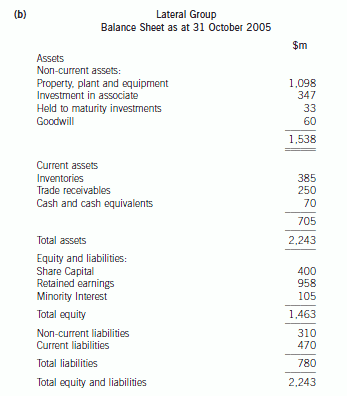
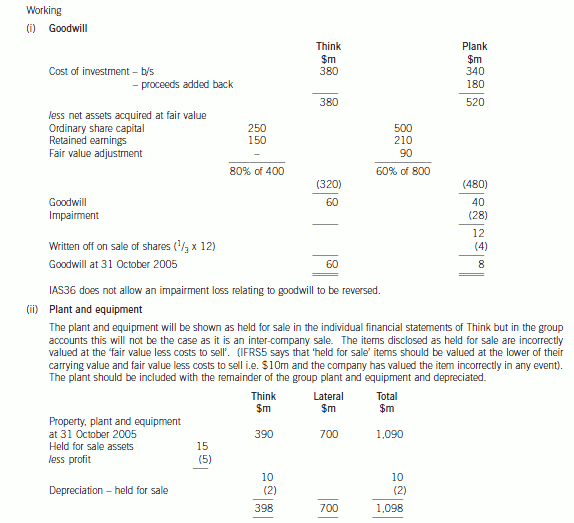
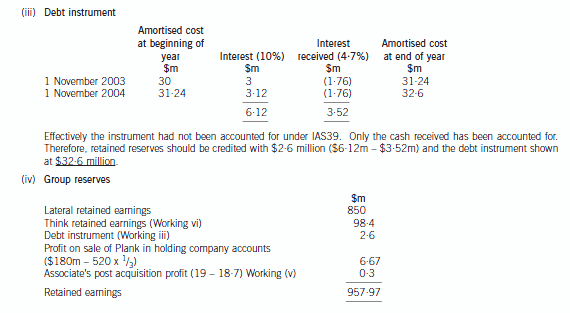
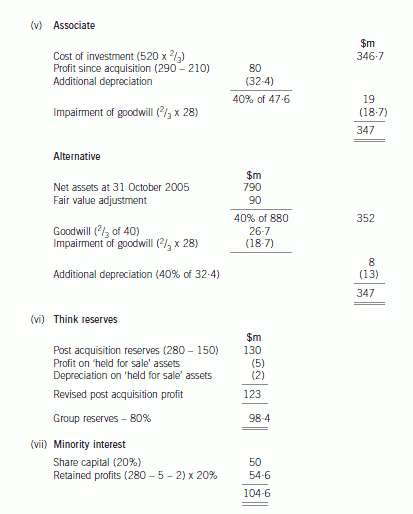
-
第14题:
(b) Prepare a consolidated statement of financial position of the Ribby Group at 31 May 2008 in accordance
with International Financial Reporting Standards. (35 marks)
正确答案: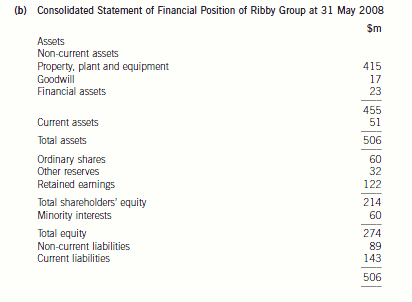


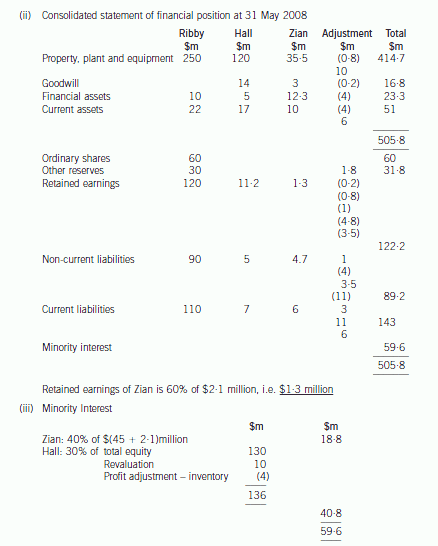
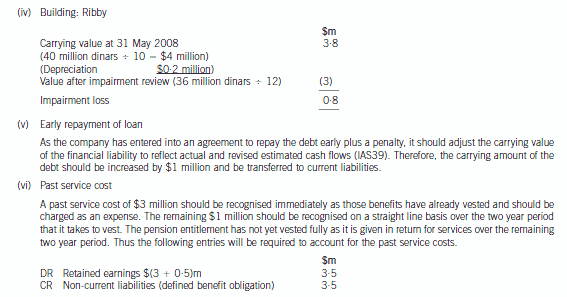
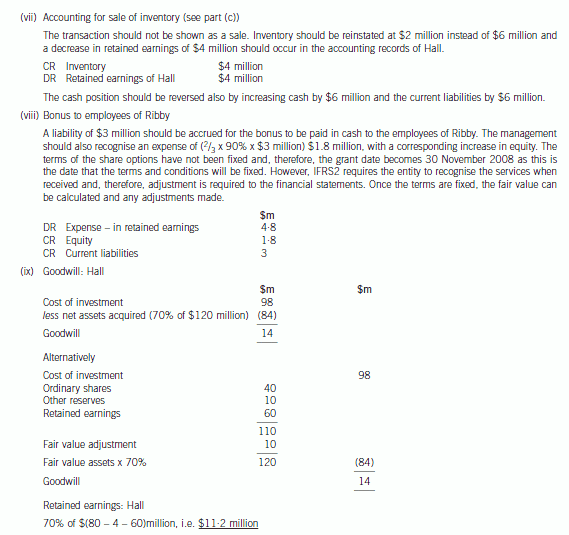

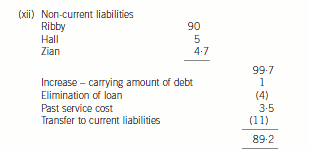
-
第15题:
(b) The Sarbanes-Oxley Act contains provisions for the attestation (verification) and reporting to shareholders of
internal controls over financial reporting.
Required:
Describe the typical contents of an external report on internal controls. (8 marks)
正确答案:
(b) Internal control statement
The United States Securities and Exchange Commission (SEC) guidelines are to disclose in the annual report as follows:
A statement of management’s responsibility for establishing and maintaining adequate internal control over financial reporting
for the company. This will always include the nature and extent of involvement by the chairman and chief executive, but may
also specify the other members of the board involved in the internal controls over financial reporting. The purpose is for
shareholders to be clear about who is accountable for the controls.
A statement identifying the framework used by management to evaluate the effectiveness of this internal control. This will
usually involve a description of the key metrics, measurement methods (e.g. rates of compliance, fair value measures, etc)
and tolerances allowed within these. Within a rules-based environment, these are likely to be underpinned by law.
Management’s assessment of the effectiveness of this internal control as at the end of the company’s most recent fiscal year.
This may involve reporting on rates of compliance, failures, costs, resources committed and outputs (if measurable) achieved.
A statement that its auditor has issued an attestation report on management’s assessment. Any qualification to the attestation
should be reported in this statement.
Tutorial note: guidance from other corporate governance codes is also acceptable. -
第16题:
(d) Discuss the professional accountant’s liability for reporting on prospective financial information and the
measures that the professional accountant might take to reduce that liability. (6 marks)
正确答案:
(d) Professional accountant’s liability
Liability for reporting on PFI
Independent accountants may be required to report on PFI for many reasons (e.g. to help secure a bank loan). Such forecasts
and projections are inherently unreliable. If the forecast or projection does not materialise, and the client or lenders (or
investors) consequently sustain financial loss, the accountant may face lawsuits claiming financial loss.
Courts in different jurisdictions use various criteria to define the group of persons to whom independent accountants may be
held liable for providing a report on an inaccurate forecast or projection. The most common of these are that an accountant
is liable to persons with whom there is proximity:
(i) only (i.e. the client who engaged the independent accountant);
(ii) or whose relationship with the accountant sufficiently approaches privity;
(iii) and to persons or members of a limited group of persons for whose benefit and guidance the accountant supplied the
information or knew that the recipient of the information intended to supply it;
(iv) and to persons who reasonably can be foreseen to rely on the information.
Measures to reduce liability
As significant assumptions will be essential to a reader’s understanding of a financial forecast, the independent accountant
should ensure that they are adequately disclosed and clearly stated to be the management’s responsibility. Hypothetical
assumptions should be clearly distinguished from best estimates.
The introduction to any forecast (and/or report thereon) should include a caveat that the prospective results may not be
attained. Specific and extensive warnings (‘the actual results … will vary’) and disclaimers (‘we do not express an opinion’)
may be effective in protecting an independent accountant sued for inaccuracies in forecasts or projections that they have
reported on.
Any report to a third party should state:
■ for whom it is prepared, who is entitled to rely on it (if anyone) and for what purpose;
■ that the engagement was undertaken in accordance with the engagement terms;
■ the work performed and the findings.
An independent accountant’s report should avoid inappropriate and open-ended wording, for example, ‘we certify …’ and ‘we
obtained all the explanations we considered necessary’.
Engagement terms to report on PFI should include an appropriate liability cap that is reasonable given the specific
circumstances of the engagement.
The independent accountant may be able to obtain indemnity from a client in respect of claims from third parties. Such ‘hold
harmless’ clauses obligate the client to indemnify the independent accountant from third party claims. -
第17题:
听力原文:M: There are several reasons why careful analysis of financial statements is necessary. What are they?
W: First, financial statements are general-purpose statements. Secondly, the relationships between amounts on successive financial statements are not obvious without analysis. And thirdly, users of financial statements may be interested in seeing how well a company is performing.
Q: What are they talking about?
(17)
A.The methods of financial statements.
B.The necessity of careful analysis of financial statements
C.The relationship among financial statements.
D.The purpose of financial statements.
正确答案:B
解析:男士问的是仔细分析财务报表的必要性的理由,故B选项符合。D项说的是财务报表的目的,并非分析财务报表的目的。 -
第18题:
Before making a loan, potential lenders determine the borrower's ability to meet ______.
A.scheduled payment
B.his creditor
C.the government's requirements
D.financial information
正确答案:A
解析:creditor债权人,贷款者。 -
第19题:
Primary users of accounting information are accountants.()
正确答案:错
-
第20题:
What is a primary objective of the security architecture assessment? ()A. document power and UPS availability
B. to integrate routing and switching components
C. create a design specification document
D. document the customer‘s current and future technology projects
参考答案:B
-
第21题:
What is a primary objective of the security architecture assessment? ()
- A、document power and UPS availability
- B、to integrate routing and switching components
- C、create a design specification document
- D、document the customer's current and future technology projects
正确答案:B -
第22题:
问答题Practice 4 You should spend about 20 minutes on this task. The table below gives information about past and projected population figures in various countries for different years. Summarise the information by selecting and reporting the main features, and make comparisons where relevant. Write at least 150 words. Population (millions)正确答案: 【参考范文】
The chart shows population figures for four countries from 1990 to 2000 and projected growth for 2020 and 2050.
The country with the lowest population and the lowest projected growth rate is New Zealand with 3.4m in 1990 rising to 3.8m in2000 and expected to increase to 4.7m in 2050. The United States has a similar growth rate but a much larger population, starting at249.9m in 1990, reaching 275.1 m in 2000 and anticipated to increase by almost 100m over the 60 year period.
Canada's population rose from 26.6m to 31.0m between 1990 and 2000 and is expected to have increased by 50% from where it was in 1990 by 2050. The highest growth rate occurs in Australia where the population grew by 2.1m to reach 19.2m in 2000 and is predicted to reach 26 million by 2050.
Overall, the countries represented had, and are forecast to have, fairly stable rates of growth over the time period although their total populations differ markedly.解析: 暂无解析 -
第23题:
单选题What is a primary objective of the security architecture assessment? ()Adocument power and UPS availability
Bto integrate routing and switching components
Ccreate a design specification document
Ddocument the customer's current and future technology projects
正确答案: B解析: 暂无解析
